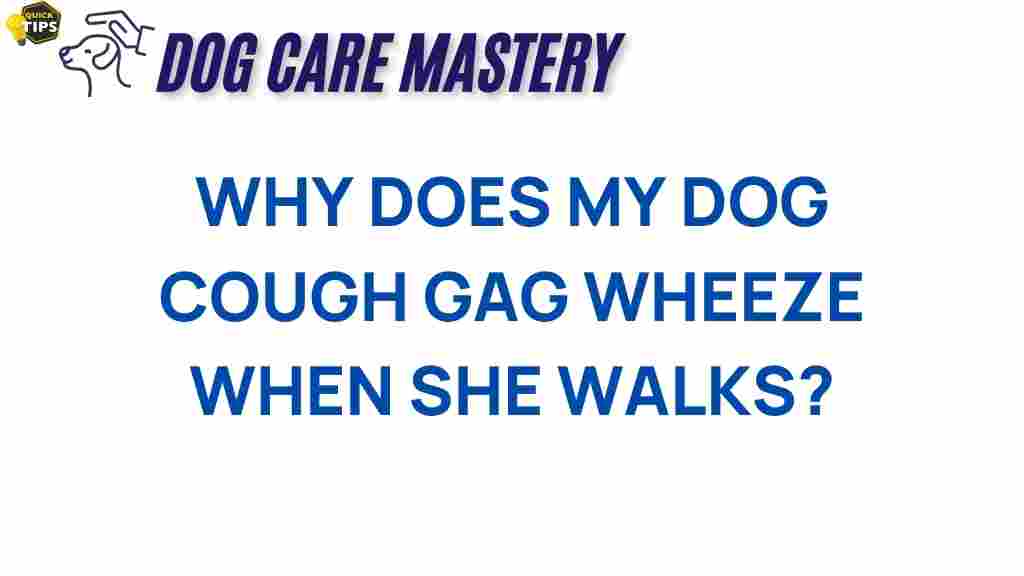Understanding Dog Cough: Why Does My Dog Cough and Wheeze When Walking?
As a loving dog owner, noticing your furry friend cough and wheeze during walks can be alarming. While occasional coughing can be normal, persistent or severe symptoms often indicate an underlying health issue. In this article, we will delve into the various reasons your dog might cough and wheeze while walking, providing you with insights and practical advice on how to address these concerns.
Common Reasons for Dog Coughing and Wheezing
Understanding the potential causes of a dog cough is the first step towards ensuring your pet’s health. Here are some common reasons:
- Allergies: Just like humans, dogs can suffer from allergies, which may cause coughing and wheezing. Environmental allergens, such as pollen, dust, or mold, can trigger these symptoms.
- Respiratory Infections: Bacterial or viral infections can lead to persistent coughing. Canine kennel cough is a well-known example that can be contracted in social settings.
- Heart Disease: Conditions such as congestive heart failure may cause a dog to cough, especially during physical activity. This occurs due to fluid accumulation in the lungs.
- Tracheal Collapse: Small breed dogs are particularly prone to this condition where the trachea becomes weak and collapses, leading to a cough that can become more pronounced with exercise.
- Parasites: Heartworms and lungworms are parasites that can reside in a dog’s system, potentially causing respiratory issues and coughing.
- Foreign Objects: If a dog inhales or swallows a foreign object, it can cause irritation in the throat or lungs, leading to a cough.
When to Seek Veterinary Help
Knowing when to consult a veterinarian is crucial. If your dog exhibits any of the following symptoms alongside coughing and wheezing, it is essential to seek professional advice:
- Persistent coughing lasting more than a few days
- Difficulty breathing or excessive panting
- Loss of appetite or lethargy
- Blue-tinged gums or tongue
- Fever or unusual nasal discharge
Step-by-Step Process: Assessing Your Dog’s Condition
If your dog is experiencing a dog cough while walking, follow these steps to assess their condition:
Step 1: Observe Symptoms
Take note of when the coughing occurs. Is it during walks, after running, or at rest? Pay attention to:
- Frequency of the cough
- Duration of the wheezing
- Any accompanying symptoms
Step 2: Check the Environment
Consider if there are any environmental triggers, such as:
- Pollen levels
- Dust or mold in your home
- Recent exposure to smoke or strong odors
Step 3: Monitor Activity Levels
Observe how your dog behaves during walks. Are they more fatigued than usual? Do they stop to cough frequently? This information can be helpful for your veterinarian.
Step 4: Keep a Record
Document your observations in a journal, noting:
- Your dog’s age, breed, and medical history
- The frequency and type of cough
- Environmental changes or potential allergens
Troubleshooting Tips for Managing Coughing and Wheezing
While waiting for your vet appointment, you can take several steps to help manage your dog’s symptoms:
- Limit Exercise: Reduce the intensity and duration of walks until you understand the cause of the cough.
- Hydration: Ensure your dog has plenty of fresh water to stay hydrated, which can help soothe throat irritation.
- Air Quality: Improve air quality in your home by using air purifiers and keeping your living space clean and free from allergens.
- Humidifier: Consider using a humidifier in your home to help ease respiratory discomfort.
- Regular Vet Check-ups: Schedule routine veterinary visits for vaccinations and overall health assessments.
Understanding the Diagnostic Process
When you take your dog to the veterinarian for coughing and wheezing, they will likely perform a series of diagnostic tests to identify the underlying cause:
- Physical Examination: The vet will start with a thorough examination, listening to your dog’s heart and lungs.
- X-rays: Chest X-rays can help identify any abnormalities in the lungs or heart.
- Blood Tests: Blood work can reveal infections, inflammation, or other health issues.
- Bronchoscopy: In some cases, a bronchoscopy may be performed to visualize the airways directly and collect samples.
Preventive Measures for Your Dog’s Health
Preventing respiratory issues is key to keeping your dog healthy. Here are some measures you can take:
- Vaccinations: Keep your dog up to date with necessary vaccinations to protect against respiratory infections.
- Avoid Exposure: Limit exposure to known allergens or irritants, such as smoke, dust, and pollens.
- Healthy Diet: Invest in a balanced diet that supports your dog’s immune system.
- Regular Exercise: Maintain a routine of moderate exercise to keep your dog fit while being mindful of their respiratory health.
Conclusion
In conclusion, noticing a dog cough and wheeze while walking can be concerning for any pet owner. By understanding the potential causes and taking the necessary steps to address the symptoms, you can help your dog lead a healthier, happier life. Always consult your veterinarian when in doubt, especially if the symptoms persist or worsen. Early intervention can make a significant difference in your dog’s health and well-being.
For more information on canine health, visit the AKC website for reputable resources. You can also check out our guide on preventive pet care to ensure your furry friend stays healthy.
This article is in the category Health and created by dogcaremastery Team
